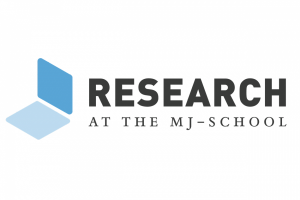Research Publication Roundup: January 2018

A vibrant and collaborative interdisciplinary research culture at the UNC Hussman School of Journalism and Media creates new knowledge, advances scholarship and helps reinvent media. Below is a list of recently published or presented scholarship by Hussman School faculty and students.
RECENT PUBLICATIONS
Kreiss, D. (2017). The fragmenting of the civil sphere: How partisan identity shapes the moral evaluation of candidates and epistemology. American Journal of Cultural Sociology, 5(3), 443-459. doi:10.1057/s41290-017-0039-5
This paper looks at Donald Trump’s strategies and tactics for appealing to core supports and Republicans, in general, during the 2016 U.S. presidential election. This paper argues that Trump was able to exploit partisan identity becoming the key basis for moral evaluation among the democratic public. This paper also argues that partisan identity has fractured civic epistemology, the basis upon which people understand and agree upon political facts and truths.
Farman, L., Riffe, D., Kifer, M., & Leder Elder, S. (2018). Finding the Truth in Politics: An Empirical Validation of the Epistemic Political Efficacy Concept. Atlantic Journal of Communication, 26(1), 1-15. doi:10.1080/15456870.2018.1398162
This paper presents results from a telephone survey of North Carolina registered voters in a presidential campaign. The survey attempted to validate the concept of epistemic political efficacy (EPE), or belief one can discover the “truth” in politics, and applied to modern information-seeking behaviors. This study demonstrates that EPE adds predictive power beyond commonly used measures such as individual political efficacy for contemporary media use variables like online information seeking and partisan cable viewing. EPE was a stronger positive predictor of online information seeking than individual political efficacy. In addition, viewing partisan cable shows had a stronger relationship with EPE than mainstream TV news viewing, and EPE significantly predicted MSNBC viewing. Overall, the paper suggests that voters who are high in the belief that political facts or “truths” exist take steps to find and understand them.
Noar, S. M., Leas, E., Althouse, B. M., Dredze, M., Kelley, D., & Ayers, J. W. (2017). Can a selfie promote public engagement with skin cancer? Preventive Medicine. doi:https://doi.org/10.1016/j.ypmed.2017.10.038
This paper looks at social media’s potential impact in promoting skin cancer prevention. In particular, this study looks at an April 2015 post in which a person shared a graphic skin cancer selfie on Facebook that subsequently went viral. This paper examined the volume of comments and shares of the original Facebook post; news volume of skin cancer from Google News; and search volume for skin cancer Google queries. This was compared to latter metrics after the post against expected volumes based on forecasts of historical trends. All search queries for skin cancer increased 162% and 155%, when news about the skin cancer selfie was at its peak. Google searches about skin cancer prevention and tanning were also significantly higher than expected volumes. This paper concludes that an ordinary person's social media post caught the public's imagination and led to significant increases in public engagement with skin cancer prevention. Digital surveillance methods can rapidly detect these events in near real time, allowing public health practitioners to engage and potentially elevate positive effects.
Berman, M. L., Byron, M. J. Hemmerich, N., Lindblom, E. N., Lazard, A. J., Peters, E., & Brewer, N. T. (2017). Communicating tobacco product information to the public. Food and Drug Law Journal, 72(3).
This paper analyzes FDA’s legal obligation to publish tobacco constituent information so that it is “understandable and not misleading to a layperson.” It also discusses how that legal analysis has guided scientific research examining how members of the public interpret messages regarding tobacco constituents. Lastly, this paper concludes with policy recommendations for FDA as it considers how to comply with the law’s constituent disclosure requirement while still furthering its overall objective of promoting public health.